#chlamydomonas-like algae
Note
Here's some fun biology stuff i have stumbled while reading the papers on the bugs surviving in the cold regions because i was thinking of GeorgeHD - snow algae! "Chlamydomonas nivalis" usually - has very beautiful life cycle, visually-wise - in the spring and summer, it is green, then, by the end of the summer, they start losing their strongly green pigmentation, and get at first orange, then, by the winter, red - they do this to protect the newly-formed zygotes from increasing radiation caused by the Sun. Those algae live, as their little name suggests, in the snow - which means, whenever they are present, snow looks green, red-like orange, or pink-ish red, like someone got murdered! Cant stop thinking about it and how to incorporate it anywhere XD - Corny
ooo that's so cool, maybe if you see him with horns and a cape, his cape leaves a trail of snow and his horns snow in the algae ?
9 notes
·
View notes
Text
Gardenia Gang
@drops-of-moonlights @emsartwork I hope you two don’t mind me mentioning you again, If you guys want me to stop just let me know.
So I drew pictures of 4/5ths of the Gardenia Gang and while they are’nt my best works I hope they are acceptable, also fair warning my phone’s camera is garbage.

First up is Levina Brand, Fairy of Lightning. She’s the youngest of the group being 17 when the main plot of the Legendarium going missing kicks off. She’s shown jumping over an obstacle instead of flying in her Basix Form (Basic-> Basix) since due to being short a limb her balance is off so she is not that great at flying.
This is a better look at her Basix form
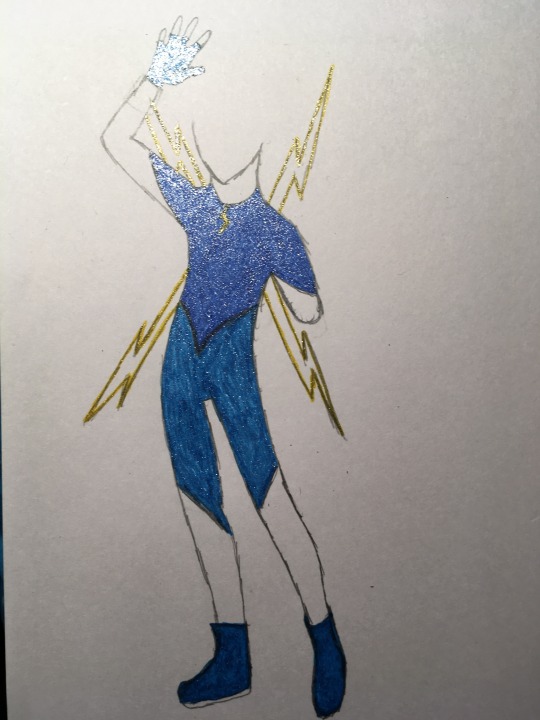
And a close up of her face.
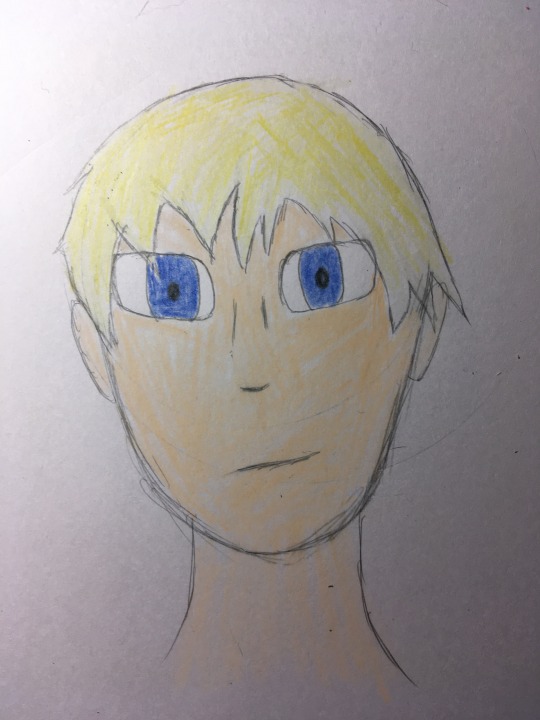
Next is Sagan Morozov
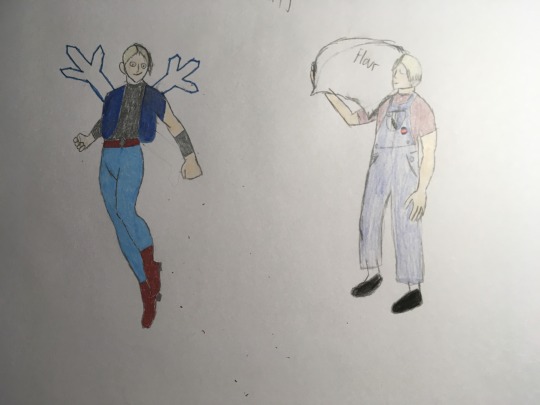

His Fairy form is more pastel and is supposed to reference the main two colors associated with snow white and blue with the pink accents referencing the phenomenon where blooming green algae called Chlamydomonas Nivalis when they bloom they turn red which when the algae is in snow turns it pink. He is 28 when the Legandarium Plot kicks off.
Entishal Ayad is next
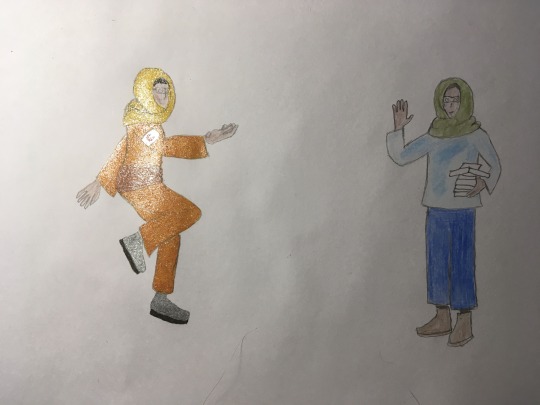
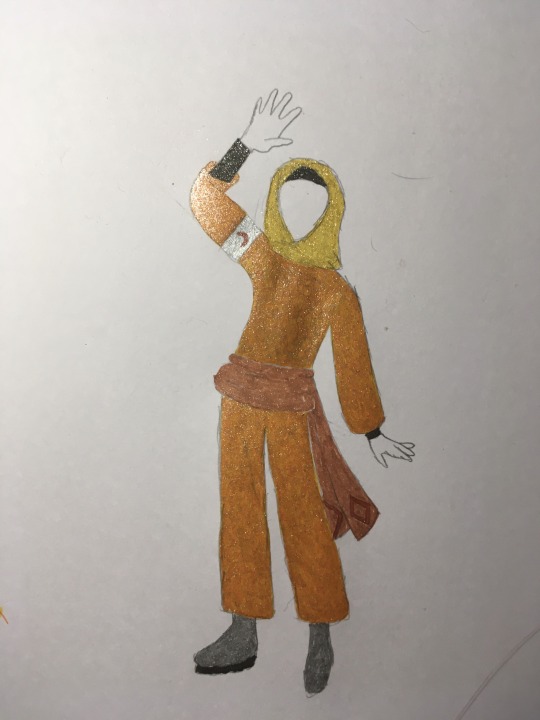
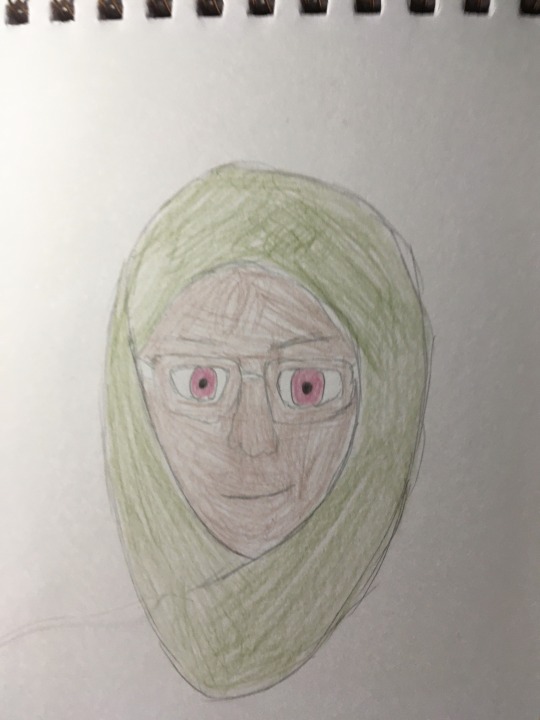
Entishal’s fairy form derives heavily from what I conceived in the original post but I enjoy it. The Orange lets her stand out very easily functioning similarly to high visibility jackets emergency responders wear. The red crescent on her armband and red diamonds on her sash are alternate symbols for the Red Cross which is often used to signify medical equipment. The red Crescent is used in Islamic countries specifically. Her sash is removable so the fabric can be used to fashion slings to brace injuries or to be used as bandages in a emergency. Her wings are supposed to invoke the Caduceus which is a very similar symbol to the Rod of Asclepius which is used as a symbol for medicine. She is also 28
The last images are of Selina. I was getting tired at this point so they are the simplest.
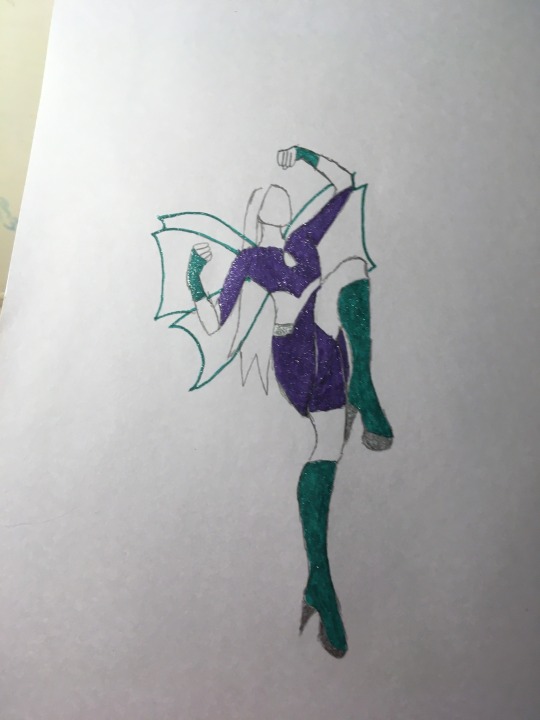
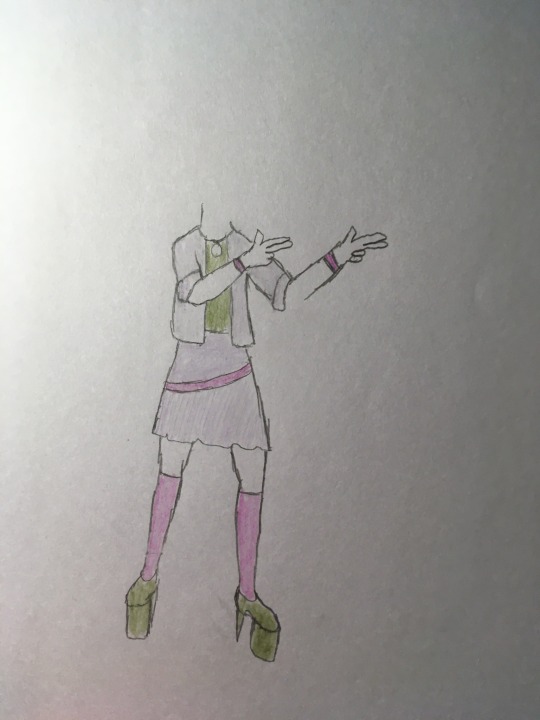
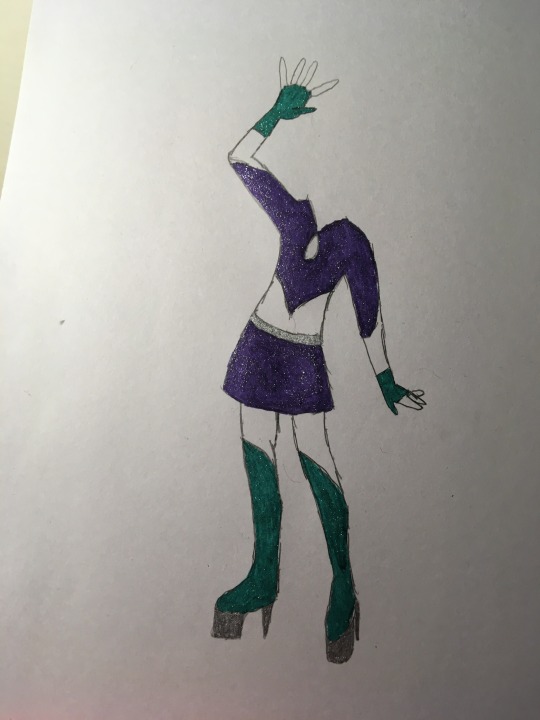
Selina’s Basix form is the most Winx like and I pulled a little color inspiration from W.I.T.C.H. But I think it turned out okay. Selina is 23 same as Bloom.
I used colored pencils for the non transformation images, and glitter gel pens for the Basix forms to make them pop a little more my phone camera isnt the best so the glitter dosen’t show up that well, sorry about that.
0 notes
Text
Single-cell genomics reveals the divergent mitochondrial genomes of Retaria (Foraminifera and Radiolaria)
Mitochondria originated from an ancient bacterial endosymbiont that underwent reductive evolution by gene loss and endosymbiont gene transfer to the nuclear genome. The diversity of mitochondrial genomes published to date has revealed that gene loss and transfer processes are ongoing in many lineages. Most well-studied eukaryotic lineages are represented in mitochondrial genome databases, except for the superphylum Retaria- the lineage comprising Foraminifera and Radiolaria. Using single-cell approaches, we present two complete mitochondrial genomes of Foraminifera and two near-complete mitochondrial genomes of radiolarians. We report the complete coding content of an additional 14 foram species. We show that foraminiferan and radiolarian mitochondrial genomes encode a nearly fully overlapping but reduced mitochondrial gene complement compared to other sequenced rhizarians. In contrast to animals and fungi, many protists encode a diverse set of proteins on their mitochondrial genomes, including several ribosomal genes; however, some aerobic eukaryotic lineages (euglenids, myzozoans, and chlamydomonas-like algae) have reduced mitochondrial gene content and lack all ribosomal genes. Similar to these reduced outliers, we show that retarian mitochondrial genomes lack ribosomal protein and tRNA genes, contain truncated and divergent small and large rRNA genes, and encode only 14-15 protein-coding genes, including nad1, 3, 4, 4L, 5, 7, cob, cox1, 2, 3, atp1, 6, and 9, with forams and radiolarians additionally encoding nad2 and nad6, respectively. In radiolarian mitogenomes, a non-canonical genetic code was identified in which all three stop codons encode amino acids. Collectively, these results add to our understanding of mitochondrial genome evolution and fill in one of the last major gaps in mitochondrial sequence databases. http://dlvr.it/ShyJcl
1 note
·
View note
Text
The signal state igg

tricornutum to 9% of total soluble protein. A fully-assembled and functional human IgG antibody against the Hepatitis B Virus surface protein (HBsAg) was shown to accumulate in P. Recent work revealed that other species like the diatom Phaeodactylum tricornutum can express foreign proteins with high efficiency also from nuclear promoters having the advantage that even complex eukaryotic proteins can be synthesized, which need post-translational modifications and the assembly of multiple subunits. Research in that field focused so far mainly on the green alga Chlamydomonas reinhardtii demonstrating that medical relevant proteins like antibodies, hormones and vaccines can be produced very efficiently in the chloroplast of the cells. Additionally, microalgae are fueled by photosynthesis and work CO 2-neutral making them very interesting as low-cost environment friendly protein factories. Microalgae combine various advantages of classical expression systems as they possess rapid growth rates, are very easy to handle, provide eukaryotic post-translational modifications and are no host to human pathogens. Classical expression systems like bacteria, yeast or mammalian cell cultures all depend on external carbon sources emerging as an important cost factor in large-scale expression. No matter if enzymes, hormones, antibodies or biotechnological relevant protein compounds – today there is a great demand for recombinant proteins especially in medical and industrial sectors. Īnother aspect of algal biotechnology is the idea of using microalgae as expression systems for recombinant proteins. Especially within the last decade microalgae came into focus of fuel industry as a renewable and beneficial source of lipid interesting for biodiesel production. But also in biotechnical applications microalgae offer enormous potential and have been used in food and cosmetic industry already for many years now as certain species represent a natural source of omega-3-fatty acids, vitamins, pigments and anti-oxidants. Microalgae are of great ecological importance as they represent a major source of global oxygen and contribute critically to carbon fixation. Microalgae combine rapid growth rates with all the advantages of eukaryotic expression systems, and offer great potential for solar-powered, low cost production of pharmaceutical proteins. tricornutum is not known to naturally secrete many endogenous proteins, the secreted antibodies are already very pure making extensive purification steps redundant and production extremely cost efficient. We engineered the diatom Phaeodactylum tricornutum to synthesize and secrete a human IgG antibody against the Hepatitis B Virus surface protein. In this study, we show for the first time that completely assembled and functional human IgG antibodies can not only be expressed to high levels in algal systems, but also secreted very efficiently into the culture medium. Still underestimated, though, is the idea of using microalgae as solar-fueled expression system for the production of recombinant proteins. Microalgae have enormous potential for diverse biotechnological applications and currently attract much attention in the biofuel sector. Although there are many different expression systems for recombinant production of pharmaceutical proteins, many of these suffer from drawbacks such as yield, cost, complexity of purification, and possible contamination with human pathogens.

0 notes
Text
Thunderwater Lake Route (heli-hiking)
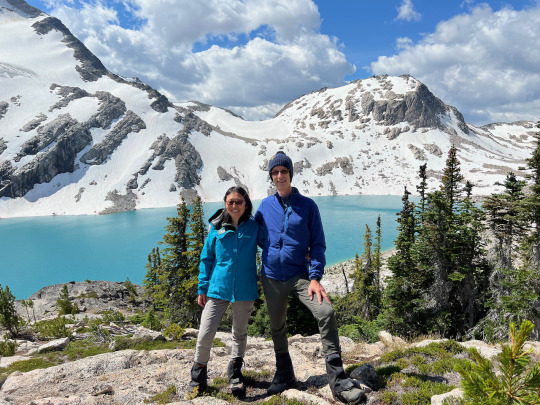
Date: 08/02/2022
Country: Canada
Region: The Bugaboos (in Purcell Mountain Range), British Columbia
Trailhead: None (cross-country hiking)
Length: 6 miles
Elevation gain: 2,600 ft
This was our second heli-hike, and it confirmed our first enthusiastic impression from the previous day. As a mode of hiking, it offers a plethora of advantages: A) You quickly get to remote locations; B) you are transported above the tree line, so hiking starts and ends with views; C) There is never an in-and out trail, but it goes from A-B with ever-changing scenery; D) Since you find yourself in scenic spots both much earlier and much later in the day than would be possible on regular day-hikes, you can catch the best light conditions for photography in spectacular surroundings high up; E) The hikes are mostly cross-country, away from trails, which means that the flora and fauna are untrammeled and plentiful; F) And finally, you enjoy near complete solitude up there among the glaciers and peaks (except for the fellow hikers in your small group).
Oh, there’s one more bonus (though this may be a matter of personal taste): We never knew exactly where we were would be dropped off at any given day. The guides have a meeting in the morning, and--depending on the weather forecast, the conditions on the ground, the participants’ hiking proficiency, as well as other factors such as wildlife activity--they decide each group’s route for the day. We as clients are simply herded into the heli, and then we take off to parts unknown--at least unknown to us. Every day thus starts with a surprise.
This morning, after a short 5-minute flight, we were dropped off on a ridge across from a yellow limestone wall dramatically lit up by the slanting sun.

The heli’s take-off pressed us into the ground with its powerful rotor wash. Then we got up, dusted ourselves off, and took a good look at the surroundings. Right below us, we spied the first of five scenic lakes strung along today’s route. However, we were headed in the opposite direction from that lake, and as soon as we turned around a ledge to start descending a rocky slope, a sharp wind sweeping down from the icefields sprung into our faces, reminding us that we were in truly wild territory.
A little later, lake #2 came into view, still mostly frozen, and covered with a thin layer of red algae dubbed “watermelon snow.”
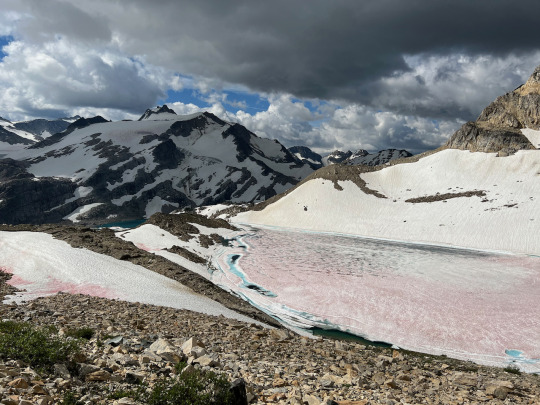
This type of algae, named Chlamydomonas Nivalis, lives on snow, where it produces a secondary, red pigment to protect the chlorophyll from the sun’s UV light, like a “sunscreen.” Nature is amazing!

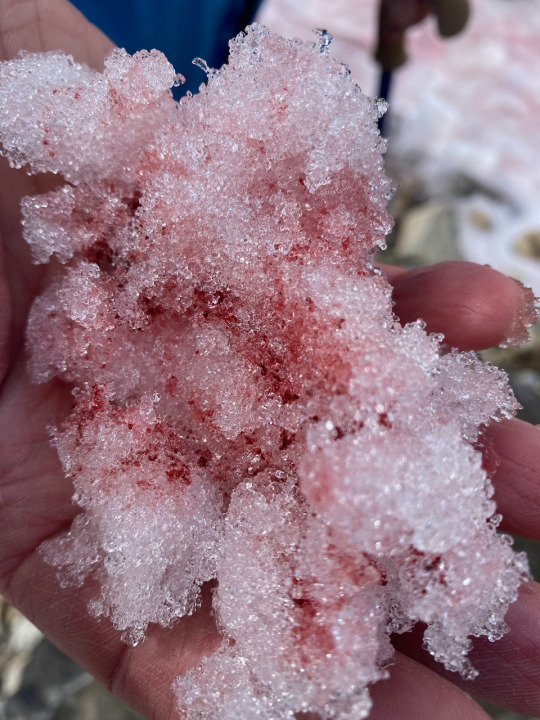
We continued scrambling for another hour, navigating a steep scree slope, crossing a boulder field, and following the steps cut by Hans into a tilted snow field. In this way we slowly approached Thunderwater Lake. After ascending an extended snowfield, we topped the comb of the ridge and then looked down upon the luminous lake, ringed by snow-covered mountains--high-alpine views at their best.

Following the shore of Thunderwater Lake, we proceeded another half-mile uphill until we arrived at lake #4, which was 50% covered with chunks of ice coated in watermelon snow. Here we had a most delightful picnic lunch, tucking into the sandwiches provided by the lodge while clouds chased each other across a blue sky, with corresponding patterns of light and shade gliding over the rock, ice, and water.
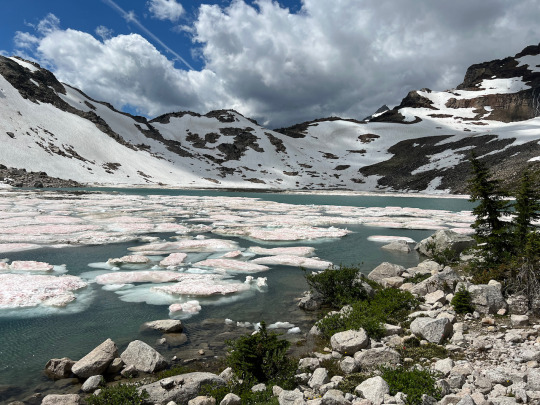

The next segment of our hike included a long uphill slog over a steep snowfield. Again, the icepick came out, as Hans cut steps into the hardened snow to create an improvised stairway. One member of our group didn’t have poles and kept falling down, an object lesson in bringing the right equipment for this kind of territory.

The final portion of the hike required navigating a boulder field, and here we proceeded very slowly, picking our individual way by hopping from rock to rock. Our peculiar hiking technique, i.e. holding hands while using the opposite arm to support supporting ourselves on hiking poles, came in very handy--literally--in this stretch of the hike. We are such a well-practiced team using this technique that we can pretty much outpace everybody, except our guide. After about an hour of such scrambling, we arrived at lake #5, a partially frozen mountain tarn cradled in a small depression at the foot of a hanging glacier.

Sliding down to the lake sitting on our bottoms or skidding along on our boots was great fun. Then we took our time for another snack break, watering up, and enjoying the stunning scenery with clear views across the lake to the distant snow-clad peaks.
Half an hour later, the chopper’s percussive clatter suddenly echoed from the surrounding cliffs, and then the heli swung into view, banking steeply to the left, making a turn and then coming to rest on a nearby natural snow platform.
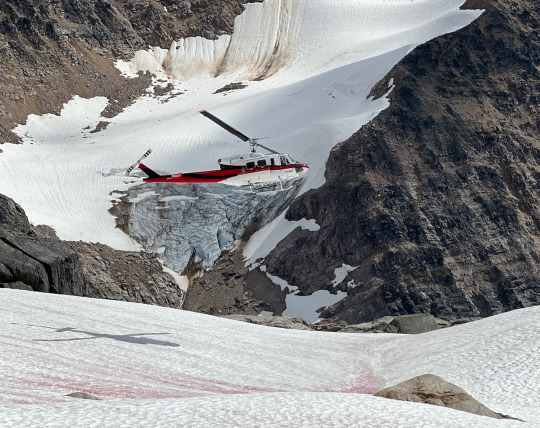
Our pilot, Jens, had arrived early, and while we were heading over to the landing site, he cut the engine and sauntered toward us, evidently in no hurry and happy to pose for pictures. A wonderful day thus came to an apt conclusion.
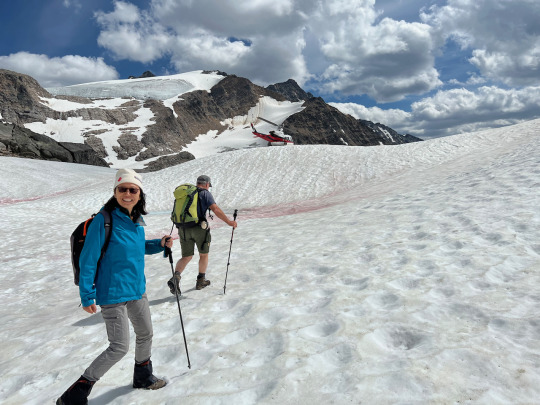
1 note
·
View note
Text



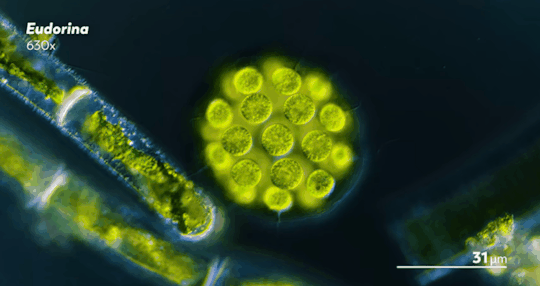


"You've got your gonium, looking like several of those little green algae stuck together. And then there's this active pandorina, also packing together several green cells in its colony body as it moves around. And then we see the Eudoria... and then the pleodorina, which looks increasingly like the orderly sphere of the Volvox. In fact, this combination of footage feels less like a family portrait and more like a series of yearbook photos taken from kindergarten through senior year. Expect instead of the striking passage of time documented through the changes in a child's face, this is the striking passage of multicellular evolution documented through the changes in on algal family."
Journey to the Microcosmos- How Did Multicellularity Evolve?
Images Originally Captured by Jam's Germs
#journey to the microcosmos#How Did Multicellularity Evolve?#science#scienceblr#biology#bioblr#microbiology#microbes#microorganisms#chlamydomonas algae#chlamydomonas-like algae#gonium#pandorina#eudorina#pleodorina#volvox#science aesthetic#reblog
371 notes
·
View notes
Text
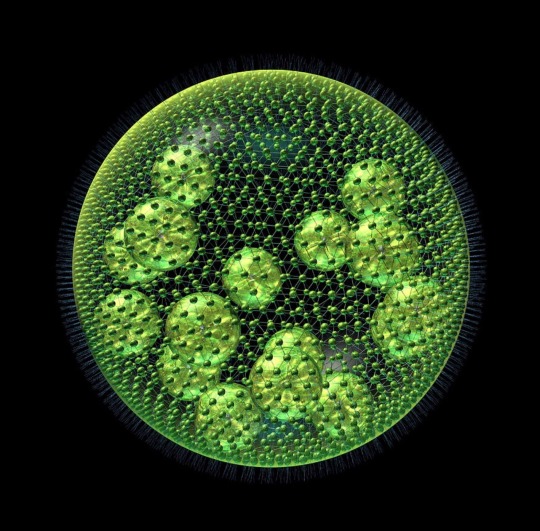
Volvox by Russell Kightley
Volvox, a spherical colonial green alga found in ponds and other freshwater. Its level of organisation is somewhere between a colony and a multicellular organism. This makes it a popular choice for the biology curriculum. Here you can see the many chlamydomonas like cells with their outwardly pointing flagella creating the hollow ball. Inside are daughter colonies waiting to be released.
25 notes
·
View notes
Text
Canadian-Iranian designer Roya Aghighi has created clothes made from algae that turn carbon dioxide into oxygen via photosynthesis, as a more sustainable alternative to fast fashion.
...
To make the fabric for Biogarmentry, chlamydomonas reinhardtii, a type of single-cell green algae, are spun together with nano polymers.
The result, which feels like linen, is "the first non woven living and photosynthetic textile" to be created.
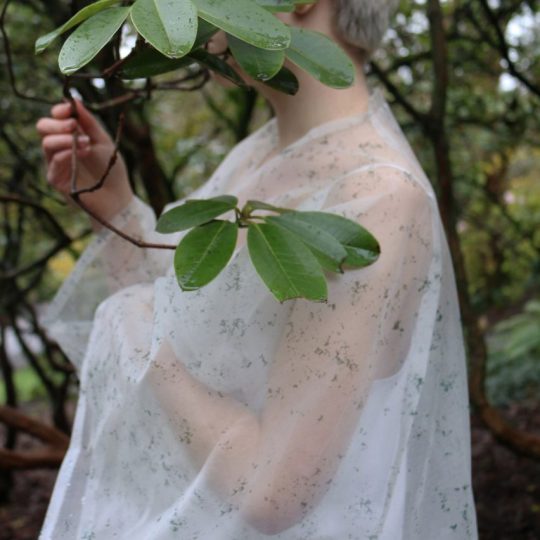
Wearers would need to take care of their garment as they would a plant in order to keep them alive, rather than engaging in the environmentally destructive practice of making synthetic clothes and discarding them after a few uses.
Biogarmentry is activated by being exposed to sunlight. Rather than wash their clothes, the owner would just need to spray them with water once a week.
"By making textiles alive, users will develop an emotional attachments to their garments," said Aghighi.
94 notes
·
View notes
Text
Researchers Discover How Human Sperm Really Swim
https://sciencespies.com/nature/researchers-discover-how-human-sperm-really-swim/
Researchers Discover How Human Sperm Really Swim

In 1677 Anton van Leeuwenhoek, Dutch scientist and inventor of the first compound microscope, finally gave into peer pressure from his colleagues and used the tool to examine his own semen. The wriggling “animalcules” that he described would come to be known as individual sperm cells, or spermatozoa. Each had a rounded head and, van Leeuwenhoek thought, a tail that moved side to side to project it through fluid. Until now, pretty much everything scientists know about human sperm movement has been based on van Leeuwenhoek’s primitive observations. But a paper published today in Science Advances has upended roughly 350 years’ worth of assumptions about reproduction, the most essential of biological functions.
“There’s just complete misinformation in almost the entire history of understanding sperm functional biology, and it needs to be corrected, but it’s a real challenge,” says Scott Pitnick, an evolutionary biologist who studies sperm biology at Syracuse University and who was not involved in the study. “And this is one of the first studies that has really risen to that challenge and cracked sort of a complex problem.”
Using 3-D microscopy and advanced mathematical analyses, an international team of researchers from the University of Bristol in England and the Universidad Nacional Autonoma de Mexico discovered that the human sperm tails’ snakelike movement is an optical illusion. Rather than moving side-to-side, sperm tails actually turn in only one direction. Without other adjustments, a one-sided stroke would result in sperm swimming in circles and never reaching their destination, the female egg. To compensate, the scientists found, the body or head of the sperm rotates independently in a corkscrew-like motion in the opposite direction, enabling the whole cell to move forward in a straight line.
“We were not expecting to find what we found,” says Hermes Gadêlha, head of the Polymaths Lab at University of Bristol and lead author on the study. “The aim of the project was ‘blue sky’ [or broad] research, to understand how sperm moves in three dimensions. And the result has completely changed the belief system that we have.”
youtube
The limitations of van Leeuwenhoek’s description of sperm motility were no fault of his own; he was using the most advanced technology available at the time. “To see the true movement, you would have to swim with the cell, and the way you do this, is almost like if you could get a GoPro camera and attach it to the head of the sperm, and look at the tail,” says Gadêlha.
To get an accurate picture of how a sperm cell moves, Gadêlha and his team vertically suspended sperm in a solution. They set the sperm solution in a stabilized 3-D microscope to scan for motion as a high-speed camera recorded more than 55,000 frames per second at many angles. They also attached a piezoelectric device—which measures changes in pressure, acceleration, and force by converting these properties to electrical charges—to the 3-D microscope. That device gathered information about sperm movement at the level of submicron resolution, smaller than one-millionth of a meter. By running the combined data gathered from all the machines through advanced mathematical transformations, the scientists were able to find movement averages and “see” the true directionality of the tails.
Each sperm cell moved like a spinning top, rotating around its own axis, and also around a middle axis. “What nature is telling us is that there is more than one way to achieve symmetry,” says Gadêlha. “Sperm use asymmetry to create symmetry.”
Human spermatozoa are not the only microorganisms to function this way—mouse and rat sperm and the flagella of Chlamydomonas, a type of green algae, also have asymmetric movements and an underlying asymmetric shape. This, says Gadêlha, may be indicative of universality in organizational structures across species.
Whether or not a sperm’s movement is the most efficient way to swim is hard to quantify. “We like to think that nature is optimizing things but we always have to remember that there are many competing aspects. A sperm cell is not just made to swim and find the egg, it has to find chemical cues, react to different viscosities, activate,” says Gadêlha. “At every stage you need a new super power that enables you to do these things.”
To understand the evolution of structural mechanisms within an organism, Pitnick says, it’s about understanding the familiar biological concept of form fitting function; the shape of something is designed for the job it is meant to perform. To truly understand sperm, it must be observed in its intended, selective environment—the female reproductive tract, which scientists also need to study more. “The female is a complex three-dimensional environment.,” says Pitnick. “And we don’t know very much about it, and in part that’s just been a historical, obscene male bias in doing biology.”

Sperm tail moves asymmetrically, wiggling the tail to one side only. This causes the sperm to spin in 3D.
(polymaths-lab.com)
Doctors think that this new discovery showing how sperm move can help treat infertility, a condition that affects roughly 50 million couples globally. Male biological factors are solely responsible for an average of 20 to 30 percent of cases of infertility, and contribute to about 50 percent over all. Still, these statistics are biased based on countries where data from IVF and other fertility treatments are common, so sperm factors could be even more significant than recorded. “[Male infertility] is really quite common, perhaps more common than the general public realizes,” says Cori Tanrikut, a reproductive urologist with Shady Grove Fertility Center in Maryland. “And right now, if you want to think about this study, currently, we really have limited means of improving or optimizing sperm motility.”
The more accurately scientists can understand the fundamental molecular biology of sperm motility, the better doctors may be able to address motility issues associated with infertility, says Tanrikut. She hopes that knowledge gained from future work in the field will help her offer patients less aggressive fertility treatment options, or even improve their chances of conceiving without assistance.
Implications of Gadêlha and his team’s discovery could also go far beyond the scope of what this study demonstrates about sperm. The cell as an organism makes unconscious computations and corrections, adjusting torque and movement patterns depending on the conditions around it. Understanding these mechanisms could inform soft robotics research and materials science. One of Gadêlha’s students, for example, is looking at how the body’s slight, undetectable oscillations could be useful in developing foot and ankle prosthetics.
#Nature
4 notes
·
View notes
Text
Pink Snow

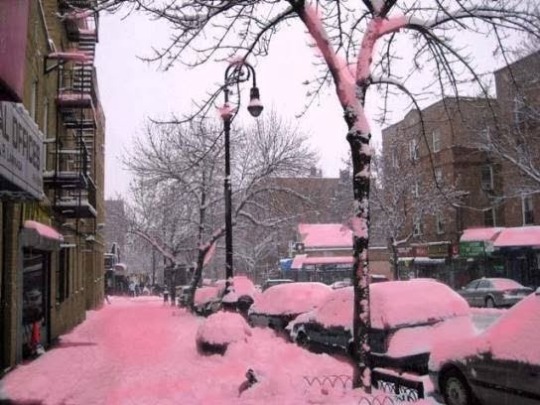
Pink snow can be found in many areas throughout the world. It is called watermelon snow because it smells and tastes like watermelon. The snow has a pink hue due to a high level of Chlamydomonasnivalisalgae, which blooms under certain temperatures and turns the snow pink due to a red pigment called astaxanthin. The pink snow is known to have laxative properties, plus bacteria could contaminate it, so I would not suggest eating it. The first mentions of pink snow are in the writings of Aristotle.
9 notes
·
View notes
Text
instagram
Canadian-Iranian designer Roya Aghighi wants you to imagine your shirt is alive and hopes that people can develop a more intimate relationship with fashion – treating clothes like living things that need our help to survive! 👗🌍
❤️Like this post to support innovators who invent new ways of cleaning the planet.
Follow @sustainabilitychampions for more positive updates!
Named Biogarmentry (@biogarmentry), the clothes are a proof of concept for a textile made with living, photosynthetic cells. Aghighi's biofabricated textiles are living organisms that respirate by turning carbon dioxide into oxygen.
To make the fabric for Biogarmentry, Chlamydomonas reinhardtii, a type of single-cell green algae, are spun together with nano polymers. The result, which feels like linen, is "the first non-woven living and photosynthetic textile" ever created.
Wearers will need to take care of their garment as they would a plant in order to keep it alive, rather than engaging in the environmentally destructive practice of making synthetic clothes and discarding them after a few uses.
Biogarmentry is activated by being exposed to sunlight. Rather than wash their clothes, the owner would just need to spray them with water once a week.
After the user is finished with the garment, it can be disposed of via composting. Currently the textile is expected to live for around a month, but this period can be extended if it is cared for properly.
To know more visit, royaaghighi.com
🔔Subscribe to our podcast on Apple Podcasts, Spotify, or any other podcast app!
📺 Visit our Youtube Channel, Sustainability Champions!
🎗️Join our Facebook group: Sustainability Champions.
Share the good news, Champions! 👑
2 notes
·
View notes
Photo
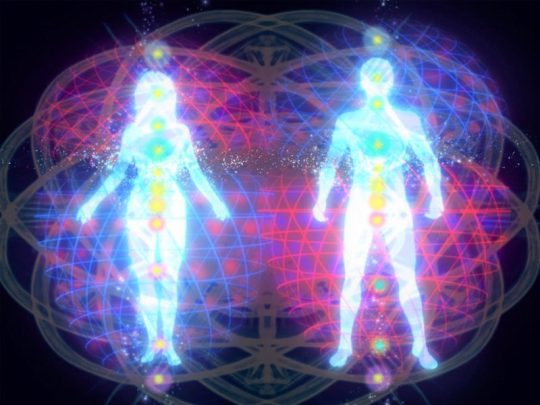
According To Science, Humans Can Feed Off Eachother’s Energies Just Like Plants. !
Studies done at Bielefeld University have proven that plants can duplicate energy from other plants near them. This study also applies to other living creatures.
This can lead to further discoveries in the field of bioenergy. And this can finally prove that people can draw energy from their surroundings, just like plants.
Professor Olaf Kruse, Ph.D.led research that discovered this green alga called Chlamydomonas, not only photosynthesizes to produce energy but also originates from other surrounding plants.
All these studies have been published in the magazine Nature Communications.
Humans are just like plants, they need water and sunlight to grow.
Our bodies can absorb energy from our surroundings.
In case you’re wondering why you feel uncomfortable around certain people, this might be the reason. According to Dr. Olivia Bader-Lee, the things that bother people are mixed emotions, and the energy surrounding them.
Dr. Olaf Kruse proves that in the case of lack of energy sources, Chlamydomonas pulls it from other isolated plants in the form of cellulosic enzymes. These enzymes become simple sugar components. They are digested by the cells as a source of energy.
Even when water and light are lacking and conditions are not conducive to photosynthesis, the seaweed doesn’t stop growing. This is the first research of this type and the first discovery of this kind of thing
We only see a plant feeding on other plants according to Dr. Kruse. Scientists are trying to prove these results by experimenting with other types of algae and plants.
As technology is still proving, scientists will be able to confirm these results in humans.
Humans and plants organism is not that different. And their cells need the energy to reproduce.
The human body needs energy to overcome certain emotional stages and is also able to produce cortisol in cells to fulfill their emotional needs.
Bader-Lee also thinks that bioenergy will be easy to show us soon. Studies will finally be able to prove that humans, like animals, can be healed by simply absorbing it from one another.
He thinks that we are able to absorb energy from creatures around us in order to heal.
How can we protect the space and stop energy drains from other people?
First, we must remain focused and rooted. Staying in our spiritual self is very important so that we can feel when a person has entered our space. If we are calm, we will liberate the negative energy of other people.
Source Read More ~ https://positivecatalog.com/uncategorized/according-to-science-humans-can-feed-off-eachothers-energies-just-like-plants/
After absorbing it, we should bring that gold back into our space and our body, and then release it into our personal space.
#According To Science Humans Can Feed Off Eachother’s Energies Just Like Plants. !#Great Article Thank You Jenny
26 notes
·
View notes
Text
Battery
I am a rather boring individual. At least that’s how everyone I know calls me, it’s not that I don’t have any big hobbies or passions is just that I always had low energy. Whenever I’m in a group of people I feel drained away and talking, discussing things just seems like an unnecessary waste of the little energy I have. So, whenever I need to talk, I make sure to answer quickly and to a point. I guess that makes me boring. So, I have been researching how to gain more energy to become more ‘’interesting’’ and took upon meditation, reading that increasing my ki would help, but all that did was made me more relaxed and spaced out, not really what I was looking for. Honestly the more I read about the positive impact on meditation the more confused I got and decided to drop it. I also started to drink a lot of coffee, I love the taste and it’s something I always started to look forwards in the morning, but all that does is make me use the bathroom more often and prevent me from napping too much. One day, as I was reading random articles online, I came across a study done on how trees can be classified into 3 different categories: energy emitters, energy absorbers, and neutrals. It states that certain trees like oak, birch, pine, and maple emit energy which we humans can absorb, so it recommends buying furniture made of such trees to make your home full of positive energy and make you feel lighter. It also stated that trees like spruce and alder absorb energy making the furniture gloomier and blander, can be used to release anger and sadness, but I don’t get angry or sad, I’m just tired most of the time. This sounded interesting to me and I thought it wouldn’t hurt if I replaced the furniture in my house with wooden substitutes that would give me the energy I need. I live in a one-floor house with a small basement. It’s cozy and enough for one person to live comfortably. So spending the good part of my salary replacing furniture and surprisingly did make me feel better. Maybe we humans are quite similar to plants, I mean both suffer stress, have energies which we give away to others or absorb from them. This helped but even so, it wasn’t enough. I needed more energy, I needed to be able to socialize more without getting tired, to be able to go out and party from time to time without being call boring. So I continued to do research and look for furniture that supposed to give more energy to me, and I found a couple of very interesting things. One was a sturdy wooden butcher table, made of oak wood and had engravings of bones and flowers on its frame. I bought it. At the time wasn’t entirely sure if it was worth 500£ but once it arrived it seemed perfect. I was happy to see it, which took me by surprise as I’m used to feeling numb. Now the second thing I found was another article. This one was about alga Chlamydomonas reinhardtii. This species of plant that can release a specific enzyme when it’s low on energy, which breaks down the cellulose of neighboring vegetation and I thought if plants can do it why can’t I? I mean if plants eat plants and us humans eat both plants and meat. What is the real difference between human meat and animal meat? Meat is just meat. It’s a very well-known fact we gain energy from eating, so with this new knowledge, I changed my morning routine. I wake up around 6:30 am, go to the kitchen and start brewing some coffee. With a fresh cup, I walk down to the basement, there on the beautiful oak table lays a male guy, I don’t know the guy, he was homeless who I invited over a couple days ago. I take out a knife and start slowly make cuts in his skin, pouring some of his blood into my coffee. This usually jolts awake the person but what he can do when he’s unable to see or say anything as his mouth is gaged and eyes blindfolded, and his arms, and legs tied up to the bony protrusions of the table. As I stare at him thrashing so lively, using up so much energy it honestly thrills me. As I drink the bloody coffee, I get the energy I never thought I could have and makes me so so happy. As I finish the cup, I pick the knife again and make slow, accurate cuts to get small slices of his thigs, that’s going to be my dinner later. Since I changed my morning routine, nobody calls me boring, I’m the star of every conversation, everybody wants me around to hand out, and been called a party animal on quite a few occasions. I always lookout for the lively ones now, the ones always so full of energy. Nobody can blame, right? I’m just special, I’m trying to become an energy absorber, but I need a specific battery to recharge. Too bad that I keep using them up so quickly.
1 note
·
View note
Link
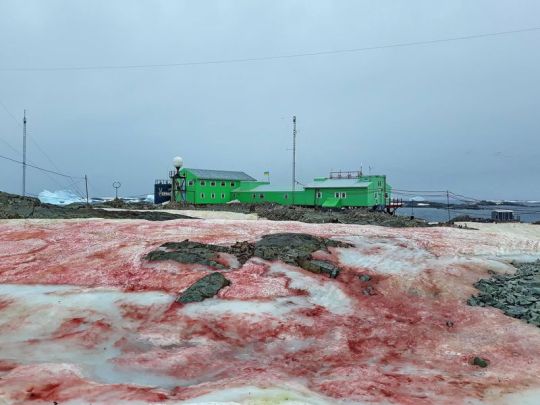
So-called 'watermelon snow' sounds better than it looks and tastes; do not eat pink snow. (Ministry of Education and Science of Ukraine)
Excerpt from this Smithsonian story:
Earlier this month, Antarctica experienced record high temperatures, causing the southernmost continent’s ice caps to melt at an unprecedented rate. As a result, Eagle Island, a small island off Antarctica’s northwest tip, experienced peak melt; brown rock appeared from beneath the ice and several ponds of melt water accumulated at the center.
And with these unprecedented temperatures, the algae that normally thrive in freezing water and lie dormant across the continent’s snow and ice are now in full bloom and cover the Antarctic Peninsula with blood-red, flower-like spores.
On February 24, the Ministry of Education and Science of Ukraine posted photos of the phenomenon to their Facebook page, showing ice around their Vernadsky Research Base—located on the Galindez Island off the coast of Antarctica’s northern Peninsula—covered in what researchers call “raspberry snow” or “watermelon snow”. This red-pigmented algae, also known as Chlamydomonas nivalis, has the potential to jumpstart a feedback loop of warming and melting, worrying scientists about the continued impact of climate change on this critical region.
“Snow blooms contribute to climate change,” the Ministry wrote on Facebook. “Because of the red-crimson color, the snow reflects less sunlight and melts faster. As a consequence, it produces more and more bright algae.”
5 notes
·
View notes
Note
Drapes! That is diabolical. It's fantastic. It's got all my special skills, even my top-ten favorite movies. What's number one? Star Wars? Nah, I don't go for that... ...kind of stuff. No wonder we shouldn't talk to them. They're out of their minds. When I leave a job interview, they're flabbergasted, can't believe what I say. There's the sun. Maybe that's a way out. I don't remember the sun having a big 75 on it.I predicted global warming. I could feel it getting hotter. At first I thought it was just me. Wait! Stop! Bee! Stand back. These are winter boots. Wait! Don't kill him! You know I'm allergic to them! This thing could kill me! Why does his life have less value than yours? Why does his life have any less value than mine? Is that your statement? I'm just saying all life has value. You don't know what he's capable of feeling. My brochure!There you go, little guy. I'm not scared of him. It's an allergic thing. Put that on your resume brochure. My whole face could puff up. Make it one of your special skills. Knocking someone out is also a special skill. Right. Bye, Vanessa. Thanks. - Vanessa, next week? Yogurt night? - Sure, Ken. You know, whatever. - You could put carob chips on there. - Bye. - Supposed to be less calories. - Bye. I gotta say something. She saved my life. I gotta say something. All right, here it goes. Nah. What would I say? I could really get in trouble. It's a bee law. You're not supposed to talk to a human.I can't believe I'm doing this. I've got to. Oh, I can't do it. Oome on! No. Yes. No. Do it. I can't. How should I start it? "You like jazz?" No, that's no good. Here she comes! Speak, you fool! Hi! I'm sorry. - You're talking. - Yes, I know. You're talking! I'm so sorry. No, it's OK. It's fine. I know I'm dreaming. But I don't recall going to bed. Well, I'm sure this is very disconcerting.
Chlamydomonas is a genus of green algae consisting of about 325 species all unicellular flagellates, found in stagnant water and on damp soil, in freshwater, seawater, and even in snow as "snow algae".
0 notes
Text

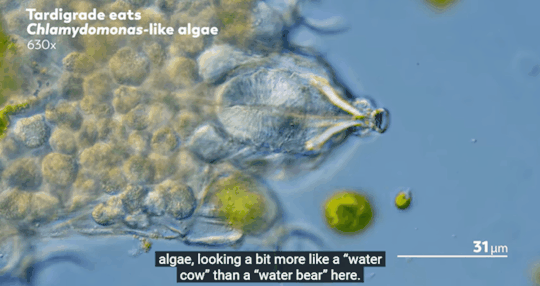
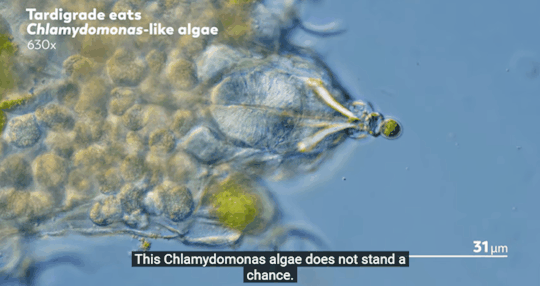
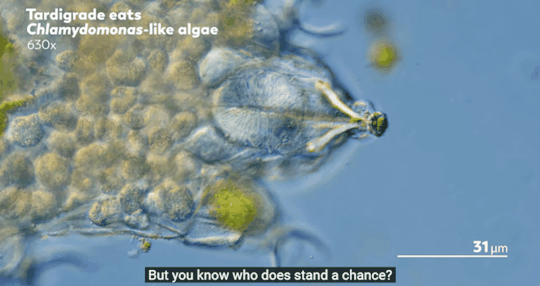

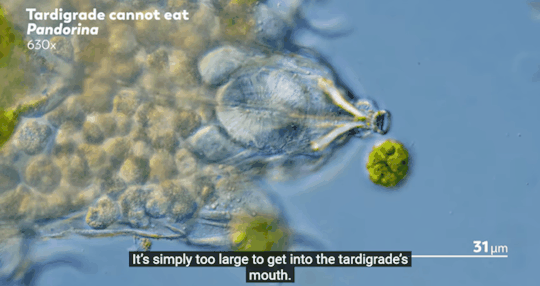
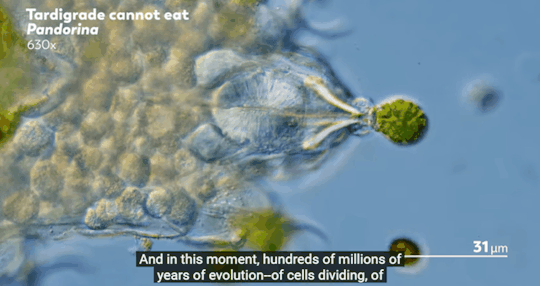
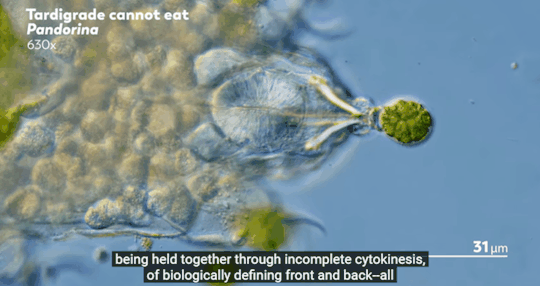
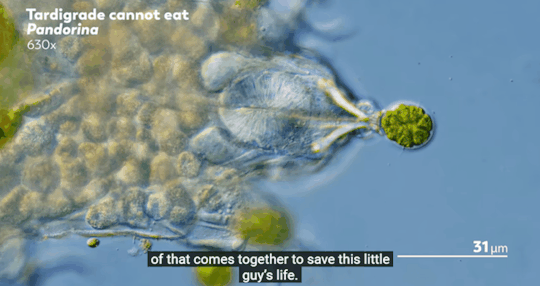
"It is a full division of labor, one that you'll find in many forms of multicellular organisms all over the planet. But why? Why go through all of this? Well, there's a lot of possible answers. But one of the simplest answers is probably captured by this tardigrade idly grazing on algae, looking a bit more like a "water cow" than a "water bear" here. This Chlamydomonas algae does not stand a chance. But you know who does stand a chance? A pandorina. It's simply too large to get into the tardigrade's mouth. And in this moment, hundreds of millions of years of evolution--of cells dividing, of being held together through incomplete cytokinesis, of biologically defining front and back--all of that comes together to save this little guy's life."
Journey to the Microcosmos- How Did Multicellularity Evolve?
Images Originally Captured by Jam's Germs
#journey to the microcosmos#How Did Multicellularity Evolve?#science#scienceblr#biology#bioblr#microbiology#microbes#microorganisms#tardigrade#chlamydomonas algae#algae#pandorina#science quote
338 notes
·
View notes